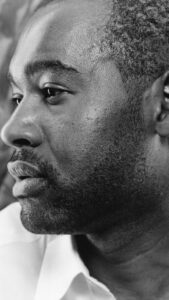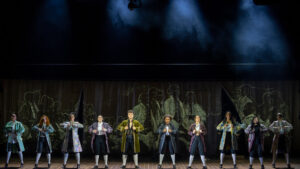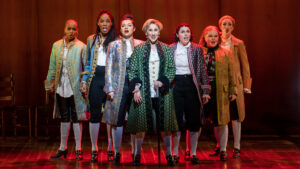
If there is anyone busier than costume designer Emilio Sosa working on Broadway this season, I’d love to meet that person. For the 2022-2023 season, Sosa has designed costumes for the revival of Sweeney Todd, the play Ain’t No Mo’, A Beautiful Noise (the Neil Diamond musical); Good Night, Oscar and the revival of the musical 1776.
That last show is currently on tour around America. 1776 opens at the Ahmanson Theatre in Los Angeles on April 11th where it will run through May 7th. From there the show goes to San Diego and San Jose. You can find all the tour stops here.
The musical, by Sherman Edwards and Peter Stone, was first on Broadway in 1969. That production was nominated for 5 Tony Awards and won 3 including Best Musical.
The story is that of the discussions and arguments that preceded the writing and the signing of the Declaration of Independence with John Adams being the most forceful presence in the musical.
In 1969 there was only one role for a woman – that of Martha Jefferson (played by Betty Buckley in her Broadway debut.) This production, directed by Diane Paulus, finds not a single role is played by a man. The cast is made up entirely of women, non-binary and transgender performers. Which means Sosa had the dual challenge of representing history and accommodating contemporary bodies in clothes not originally designed for them.
I spoke with Sosa in late March about 1776 and some of his other shows in this very busy season he has. What follows are excerpts from our conversation that have been edited for length and clarity.
Thomas Jefferson wrote, and this is truncated a bit, “I am not an advocate for frequent changes in laws and constitutions, but laws and institutions must go hand in hand with the progress of the human mind.” He goes on to say that “Institutions must advance also to keep pace with the times. We might as well require a man to wear still the coat which fitted him when a boy as a civilized society to remain ever under the regiment of their barbarous ancestors.” It sounds to me like he’s advocating for exactly this production of 1776.
Thomas Jefferson enjoyed fashion. He enjoyed clothing. He enjoyed looking good. He loved French fabrics. He spent a lot of time in Paris. So he was influenced by the culture there and the way the men and the women dressed. So for him to use the analogy of clothing is so in line to the person he was in general.

For me what’s very powerful about this piece is when you hear these words spoken by people that look like you, who were never, ever represented in the room, just changes the dynamic of the course of this country. I still believe America is the best country in the world. I would not live anywhere else, but it is not without its flaws. And a major flaw traces right back to this document. That’s the central core, I think, America goes back to. Unless we are willing to go to the very beginning and try to undo what was wrongfully done, we will never, ever heal as a nation.
I saw an interview that Diane Paulus gave the New York Times where she said, “Audiences are interested in looking back to our history to understand the present moment.” What is your role in making it possible for audiences who see 1776 to do exactly what she thinks they want to do?
As the costume designer, I want to give a sense of the period because the period is very specific. The interesting thing about 1776 for me is that it’s a musical, but the underlining things are so rich and deep. I don’t want to give it away for anyone who has not seen it, because the very beginning is really encompasses the entire language of the show. But it’s about when we put on the coat of history what do we learn from it.
So my job was to give the audience a sense of the history. That’s why the coats that the performers wear, the shapes are completely authentic. We researched everything that men wore at that period, what women wore, what Europeans were wearing.
Even in the book of the of the musical, the playwright give us some historical fashion history. They are very specific in the fabrics and colors that we used. They wanted to make the distinction between the pious, puritanical aspect of New England, the North, by the use of color and fabrications, earthier colors, muted colors in simpler woven fabrics versus what the South was. The South was the the central capital of the slave trade in this country. So a lot of things came from overseas fabrics. They had access to silks, to laces to buttons. We were able to show the difference in the fabrications they wore; the ornamentation because they took really pride in their way of life. That was a huge central theme in not only the musical but in our American history.Those were the themes that I wanted the audience to get.
Are there unique challenges knowing that you are not making these costumes for men, but making them for a wide spectrum of bodies that are going to be in them?

Totally. Because when you look at those patterns they were definitely made for a specific gender. When you open up the pool of humans, we’re all shaped differently. Maintaining the correct silhouette and adjusting it to a modern form, that’s always the challenge. But talented drapers and makers can make it work. It’s just a matter of adjusting the patterns and being conscious of the body in front of you and how do you dress it and not go by the textbook a bit.
It is my understanding that the mantra for the show was “to hold history as a predicament rather than an affirming myth.” For people who aren’t sure what exactly that mantra means, what would you tell them?
The way I absorbed it is history is always someone’s take on what happened. It’s debatable. It’s good to have the facts and then make your own assumptions and I think that’s the way I looked at this this show. We know what the history of it is, but let’s explore how we get there. And then if we are going to explore how we get there, we explore the people who were excluded from the table for telling you the story. History is a moving target. I also remember always hearing history is written by the winners. So how you look at it depends on what side of the argument you end up on. Some of the greatest people in our world have not been treated kindly by history.
This is not the only revival you’ve done. You did The Gershwins’ Porgy and Bess. You’re doing the Sweeney Todd production that just opened this weekend to almost universally rave reviews. Is there a difference for you or a different area of passion for you when you’re doing a revival of a production versus doing something that’s new, like Motown the Musical or Ain’t No Mo’ or Good Night Oscar?
I approached them all as new work because to me they were new, especially Sweeney. Because Sweeney Todd is mythical. People have these memories attached to this show at some point or another in their lives. Now that I know it so well, I can understand why. I think it’s one of the most joyously written musicals. I think of the musical as a horror musical.

Sweeney Todd never done it, never seen a production of it. I just knew some of the songs and the legendary performers had been in it, but to me it was new. I knew was about a barber who killed people and a woman who made pies out of them. That was the core of the story. I didn’t see Sweeney as just the killer. I think what was interesting is to see the human who became that. No one starts where they end. So there had to be some kind of arc that we can trace and I think by making these characters more human made the tragedy even greater.
Oscar Levant, the subject of Good Night, Oscar, is a hugely complicated character. He’s one of my favorite people in the history of culture in this country, but words fail me for how to easily sum up who Oscar Levant was. So how did you approach Oscar Levant for Good Night, Oscar?

I saw some of Oscar Levant as our inner voice. What we want to say if we had the courage to say it. Oscar had no filter. That’s what made him brilliant. He was self-deprecating. Well, he took himself really seriously. That’s why he had those issues. I think we all wish we could live that way, especially now. In the world we live in I don’t know whether Oscar Levant could exist. Maybe he could, because you do need someone that has no filter to cut through the political correctness of our times.
What Oscar was saying at the onset of TV was already was controversial. I think he represents all of us. We’re all born with a gift. Whether or not you exercise that, you find it, you nurture it, always treat it, that’s your journey. But even when he was at his lowest mentally, he was able to give the gift that was given to him.
In the penultimate episode of Project Runway season seven, where you competed, you said “I wanted to leave a lasting impression on these judges.” With five shows this season on Broadway and you’ve worked on countless films, what’s the lasting impression you would like to leave on the people who go to the theater?
The lasting impression: we’re all in it together. Theater is a community experience and that’s what life should be. We are all in it together and if we could only look at each other as equals we will be in a much better place. That’s why I love theater so much. Once the lights go down we are all experiencing something together that’s unique for this one audience. That can never be replicated again. Theater is a great denominator. Once the lights go out, we are all the same. We’re being taken on the same journey. If we think about that in our daily lives, then I think we would be in a much better place.
Photo: The cast of the national tour of 1776 (Photo by Joan Marcus/Courtesy Center Theatre Group)












